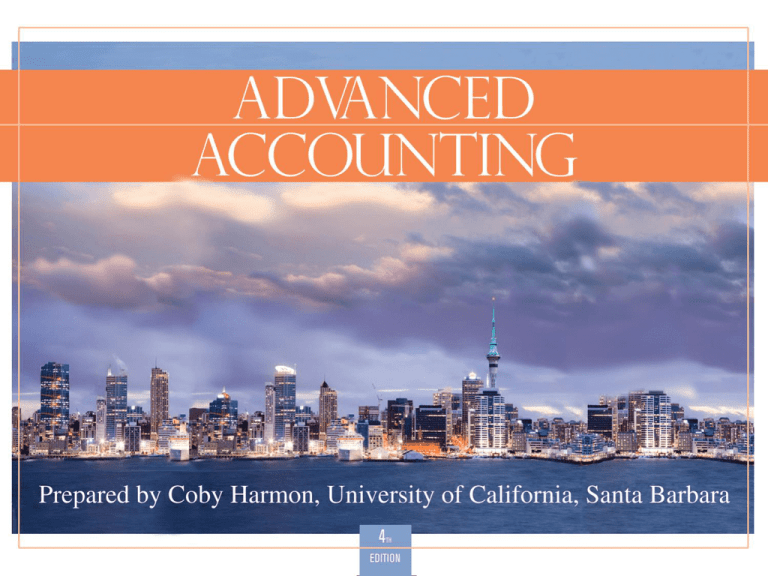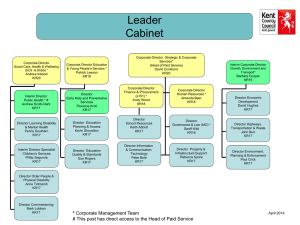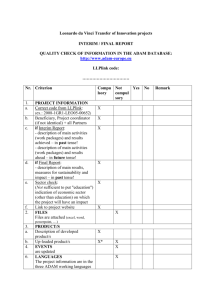
Slide
14-1
14
Reporting for Segments
and for Interim
Financial Periods
Advanced Accounting, Fourth Edition
Slide
14-2
Learning Objectives
Slide
14-3
1.
Understand the need for disaggregated financial data.
2.
Describe the basic requirements of public companies in
reporting segmental data.
3.
Determine an operating segment.
4.
Define a reportable segment.
5.
Describe how common costs are handled in segmental
reporting.
6.
Identify the information to be presented for each
reportable segment.
Learning Objectives
7.
Explain when and what types of geographic data must be
reported.
8.
Explain when information about major customers must be
reported.
9.
Compare the international accounting standards for
segmental reporting with the U.S. requirements.
10. Describe current requirements for companies to report
interim information.
11. Indicate some problems with interim reporting and the
authoritative position on the issue.
Slide
14-4
Need for Disaggregated Financial Data
Users need information to determine conditions, trends,
and ratios that assist in predicting cash flows of firms.
Different industries or geographic areas have different
rates of profitability,
opportunities for growth, and
types of risk.
Disaggregated information is useful to assist in analyzing
uncertainties surrounding expected cash flows.
Slide
14-5
LO 1 The need for disaggregated financial data.
Standards of Financial Accounting and Reporting
SFAS No. 131 [ASC 280-10-05-03], “Disclosures about
Segments of an Enterprise and Related Information.”
Primary benefit - unveiling information.
Arguments against segmental disclosures include:
May be misleading due to accounting problems, lack of
user knowledge, different measurement techniques.
Disclosures to competing firms, labor unions, etc.
Adds to already excessive amount of disclosures.
Slide
14-6
LO 1 The need for disaggregated financial data.
Standards of Financial Accounting and Reporting
Basic Disclosure Requirements (Management Approach):
Objective is to facilitate consistency between
internal and external reporting.
Segmented by
Reporting Requirement
Product or service,
Segmental profit or loss,
Geographic area,
Certain items of revenue
and expense,
Customer type, or
Legal entity.
Slide
14-7
Segmental assets, and
Other items.
LO 2 Basic disclosure requirements.
Standards of Financial Accounting and Reporting
Question
A component of an enterprise that may earn revenues and
incur expenses, and about which management evaluates
separate financial information in deciding how to allocate
resources and assess performance is a(n)
a. identifiable segment.
b. operating segment.
c. reportable segment.
d. industry segment.
Slide
14-8
Standards of Financial Accounting and Reporting
Operating Segment - Component of an enterprise that
May earn revenues and incur expenses.
Chief operating decision maker regularly reviews the
component’s operating results.
Discrete financial information is available.
Reportable Segment
Slide
14-9
Significant to an enterprise’s operations.
Has passed one of three 10% tests or
Determined to be reportable by other criteria.
LO 3 Operating segment.
LO 4 Reportable segment.
Standards of Financial Accounting and Reporting
Common Cost Allocation
Common costs should be allocated to a segment (external
reporting purposes only) if they are included in the
segment’s profit or loss calculations that are used
internally by the chief operating decision maker.
Slide
14-10
LO 5 Handling common costs.
Standards of Financial Accounting and Reporting
Determining Operating Segments
Modified Management Approach
Aggregation Criteria
Quantitative Thresholds
Slide
14-11
Standards of Financial Accounting and Reporting
Question
An entity is permitted to aggregate operating segments if
the segments are similar regarding the
a. nature of the production processes.
b. types or class of customers.
c. methods used to distribute products or provide
services.
d. all of these.
Slide
14-12
Standards of Financial Accounting and Reporting
Determining Operating Segments
Aggregation Criteria - entity is permitted to aggregate
operating segments that have similar economic
characteristics and are similar in ALL the following:
Nature of their products or services.
Nature of the production processes.
Types or class of customers.
Methods used to distribute products or provide
services.
Nature of the regulatory environment.
Slide
14-13
Standards of Financial Accounting and Reporting
Determining Operating Segments
Quantitative Thresholds - Segment is reportable if it
meets one or more of the following:
Combined (external and internal) revenue is 10% or more of
combined revenue of all reportable segments.
Profit or loss is 10% or more of the greater absolute amount
of:
Combined profit of all segments not reporting a loss.
Combined loss of all segments that reported a loss.
Assets are 10% or more of the combined assets of all
segments.
Slide
14-14
Standards of Financial Accounting and Reporting
Problem 14-1: Significance Tests—Segmental Reporting
Bacon Industries operates in seven different segments.
Information concerning the operations of these segments
for the most recent fiscal period follows:
Operating
Revenue
Segment
1
Slide
14-15
Total
$
4,200
Operating
Identifiable
Intersegment
Profit (Loss)
Assets
$
$
800
(600) $
7,000
2
6,000
1,200
2,000
8,800
3
51,000
7,000
2,100
35,400
4
48,000
-
8,800
37,600
5
13,000
-
3,200
14,000
6
64,500
3,400
4,000
52,000
7
12,000
2,000
(3,000)
16,400
Standards of Financial Accounting and Reporting
Problem 14-1: Determine which of the segments must be
treated as reportable segments.
Revenue Test
Operating
% of Total
Reportable
Revenue
Segment
4,200
2.1%
No
2
6,000
3.0%
No
3
51,000
25.7%
Yes
4
48,000
24.2%
Yes
5
13,000
6.5%
No
6
64,500
32.5%
Yes
7
12,000
6.0%
No
Segment
1
Revenue
$
$ 198,700
Slide
14-16
100.0%
Standards of Financial Accounting and Reporting
Problem 14-1: Determine which of the segments must be
treated as reportable segments.
Operating Profit Test
Operating
Operating
Segment
Profit
1
% of Largest
Operating
Loss
2,000
9.9%
No
3
2,100
10.4%
Yes
4
8,800
43.8%
Yes
5
3,200
15.9%
Yes
6
4,000
19.9%
Yes
14.9%
Yes
$
(600)
Segment
No
7
(3,000)
$
Slide
14-17
or Op. Loss
Reportable
3.0%
2
$
of Op. Profit
20,100
$
(3,600)
Standards of Financial Accounting and Reporting
Problem 14-1: Determine which of the segments must be
treated as reportable segments.
Identifiable Assets Test
Operating
Identifiable
Segment
Assets
1
$
% of Total
Segment
7,000
4.1%
No
2
8,800
5.1%
No
3
35,400
20.7%
Yes
4
37,600
22.0%
Yes
5
14,000
8.2%
No
6
52,000
30.4%
Yes
7
16,400
9.6%
No
$
Slide
14-18
Reportable
171,200
Summary: Segments 3, 4, 5, 6,
and 7 are reportable segments.
Standards of Financial Accounting and Reporting
Seventy-Five Percent Combined Revenue Test
The combined revenue from sales to unaffiliated customers
of all reportable segments must constitute at least 75% of
the combined revenue from sales to unaffiliated customers
of all operating segments.
Slide
14-19
Standards of Financial Accounting and Reporting
Review Question
To determine whether a substantial portion of a firm's
operations are explained by its segment information, the
combined revenue from sales to unaffiliated customers of all
reportable segments must constitute at least
a. 10% of the combined revenue of all operating segments.
b. 75% of the combined revenue of all operating segments.
c. 10% of the combined revenue from sales to unaffiliated
customers of all operating segments.
d. 75% of the combined revenue from sales to unaffiliated
customers of all operating segments.
Slide
14-20
Standards of Financial Accounting and Reporting
Problem 14-1 Data:
Operating
Revenue
Segment
1
75% Test
Total
$
4,200
Revenue from
Intersegment
$
Nonaffiliates
800
3,400
2
6,000
1,200
4,800
3
51,000
7,000
44,000
4
48,000
-
48,000
5
13,000
-
13,000
6
64,500
3,400
61,100
7
12,000
2,000
10,000
$
198,700
$
14,400
$
Nonaffiliated revenue (reportable segments)
Total nonaffiliated revenue
Slide
14-21
Nonaffiliated
Revenue from
reportable
segments
$176,100
184,300
$176,100
$184,300
= 95.6%
Standards of Financial Accounting and Reporting
Information to be Presented
For each reportable segments and in the aggregate for the
segments not separately reported.
General information.
Enterprise wide disclosures.
Operating profit or loss.
Product or service.
Assets.
Geographic area.
Bases for measurement.
Major customer (10%).
Interim disclosures.
Reconciliation of segment amounts and consolidated amounts
for revenue, profit or loss, assets, and other significant items.
Slide
14-22
LO 6 Reportable segment information to be presented.
Standards of Financial Accounting and Reporting
Geographic Areas
Where operations in foreign countries are grouped into
geographic areas, the groupings should consider
1. proximity,
2. economic affinity,
3. similarities of business environments, and
4. the nature, scale, and degree of interrelationship of
the operations in the various countries.
Slide
14-23
LO 7 Reporting on geographical areas.
Standards of Financial Accounting and Reporting
Information about Major Customers
If 10% or more of the revenue of a firm is derived from
sales to any single customer, or
If 10% or more of the revenue is derived from sales to
the federal government, a state government, a local
government, or a foreign government,
that fact and the amount of revenue must be disclosed.
Slide
14-24
LO 8 Reporting on major customers.
Standards of Financial Accounting and Reporting
Review Question
Which of the following is not a consideration in segment
reporting for diversified companies?
a. Consolidation policy.
b. Defining the segments.
c. Transfer pricing.
d. Allocation of joint costs.
Slide
14-25
Interim Financial Reporting
Interim financial statements are presented to provide
information concerning financial status and progress for
time periods of less than one year.
Normal time period is a quarter of a year.
Prepared for most recent interim period, as well as on
a cumulative or year-to-date basis.
May consists of statements of financial position,
income, and cash flows.
SEC requires public companies to file Form 10-Q.
Slide
14-26
LO 10 Current interim reporting requirements.
Interim Financial Reporting
Problems in Interim Reporting
Seasonal nature of operations in many industries can
cause wide fluctuations in revenues and expenses.
Short time period to determine interim results.
Some accountants hold that each interim period should
stand alone as a basic accounting period.
Some accountants view each interim period as
essentially an integral part of the annual period.
In response to SEC complaints and general pressure, the
APB issued APB Opinion No. 28 in May 1973.
Slide
14-27
LO 11 Problems in interim reporting.
Interim Financial Reporting
APB Opinion No. 28 [ASC 270-10-05-1] in May 1973
“Each interim period should be viewed as an integral part of
an annual period.”
Each interim period should be based on accounting
practices used for annual statements.
Revenue should be recognized on same basis as used for
the full year.
Costs Associated with Revenue should be similarly
treated for interim purposes.
Slide
14-28
Interim Financial Reporting
Acceptable alternatives for inventory costing:
COGS can be estimated using gross profit rates.
Liquidated LIFO base should be charged at replacement
cost if expected to be replaced by year end.
Inventory loss from market declines expected to
recover before year end need not be recognized.
Standard cost for determining inventory and product
cost should be based on the procedures used for the
fiscal year.
Slide
14-29
Interim Financial Reporting
Review Question
Which of the following methods of inventory valuation is
allowable at interim dates but not at year-end?
a. Estimated gross profit rates.
b. Retail method.
c. Specific identification.
d. Weighted average.
Slide
14-30
Interim Financial Reporting
All Other Costs and Expenses (other than product costs)
Charged to income as incurred or allocated based on
an estimate of time expired,
benefit received or
activity associated with the periods.
If not readily identified with activities or benefits should
be charged when incurred.
Arbitrary assignment of costs should not be made.
Gains and losses that would not be deferred at year-end
should not be deferred at interim periods.
Slide
14-31
Interim Financial Reporting
Review Question
In considering interim financial reporting, how did the
Accounting Principles Board conclude that such reporting
should be viewed?
a. As useful only if activity is evenly spread throughout
the year so that estimates are unnecessary.
b. As a “special” type of reporting that need not follow
generally accepted accounting principles.
c. As reporting of an integral part of an annual period.
d. As reporting of a basic accounting period.
Slide
14-32
Interim Financial Reporting
Provision for Income Taxes
APB Opinion Nos. 28, 23, and 24, and in SFAS No. 109 [ASC
740-270]
At the end of each interim period the company should
make its best estimate of the effective tax rate
expected to be applicable for the full fiscal year.
Slide
14-33
Interim Financial Reporting – Income Taxes
Exercise 14-8: Spur Company’s actual earnings for the first two
quarters of 2008 and its estimate during each quarter of its
annual earnings are:
Actual first-quarter earnings
$ 400,000
Actual second-quarter earnings
510,000
First-quarter estimate of annual earnings
1,350,000
Second-quarter estimate of annual earnings
1,420,000
Spur Company estimated its permanent differences between
accounting income and taxable income for 2008 as:
Environmental violation penalties
$ 25,000
Dividend income exclusion
180,000
The combined state and federal tax rate for 2008 is 42%.
Slide
14-34
Interim Financial Reporting – Income Taxes
Exercise 14-8: Prepare journal entries to record Spur Company’s
provisions for income taxes for the first two quarters of 2008.
First Quarter
Estimated Annual Earnings
$ 1,350,000
Add: Environmental Violation Penalties
25,000
Deduct: Dividend Income Exclusion
(180,000)
Estimated Taxable Income
$ 1,195,000
Estimated Annual Income Tax Payable *
$
Estimated Effective Combined Annual Tax Rate **
37.2%
Actual First Quarter Earnings
x
400,000
First Quarter Income Tax Provision (Expense)
$
148,800
* ($1,195,000 x 42%)
Slide
14-35
501,900
** ($501,900 / $1,350,000)
Interim Financial Reporting – Income Taxes
Exercise 14-8: Prepare journal entries to record Spur Company’s
provisions for income taxes for the first two quarters of 2008.
First Quarter Journal Entry
Income Tax Expense
Income Tax Payable
Slide
14-36
148,800
148,800
Interim Financial Reporting – Income Taxes
Exercise 14-8: Prepare journal entries to record Spur Company’s
provisions for income taxes for the first two quarters of 2008.
Second Quarter
Estimated Annual Earnings
$ 1,420,000
Deduct: Net Permanent Difference ($180,000-$25,000)
(155,000)
Estimated Taxable Income
$ 1,265,000
Estimated Annual Income Tax Payable *
$
Estimated Effective Combined Annual Tax Rate **
Cumulative Income to Date ($400,000 + $510,000)
37.4%
x
$
910,000
Cumulative Tax Provision Needed
340,340
Tax Provision in 1st Quarter
148,800
Tax Provision in 2st Quarter
* ($1,265,000 x 42%)
Slide
14-37
531,300
** ($531,300 / $1,420,000)
$
191,540
Interim Financial Reporting – Income Taxes
Exercise 14-8: Prepare journal entries to record Spur Company’s
provisions for income taxes for the first two quarters of 2008.
Second Quarter Journal Entry
Income Tax Expense
191,540
Income Tax Payable
Slide
14-38
1st
2nd
1st Quarter
tax provision
= $148,800
2nd Quarter
tax provision
= $191,540 *
* $340,340 - $148,800
191,540
3rd
Year-to-Date
tax provision
= $340,340
4th
Interim Financial Reporting
Accounting Changes in Interim Periods
Changes in Estimate
Accounted for in interim period when change is made.
No restatement of previous interim reports.
Effect on earnings disclosed for current and
subsequent interim periods.
Accounting Changes and Error Corrections - SFAS No. 154
[ASC 250] requires retrospective application to financial
statements of prior periods where practical.
Slide
14-39
Interim Financial Reporting
Minimum Disclosures in Interim Reports
a.
Gross revenues, provision for income taxes, extraordinary items
(including related income tax effects), and net income.
b. Basic and diluted earnings-per-share data.
c.
Seasonal revenue, costs, or expenses.
d. Significant changes in estimates or provisions for income taxes.
e.
Disposal of a segment of a business and extraordinary, unusual,
or infrequently occurring items.
f.
Contingent items.
g.
Changes in accounting principles or estimates.
h. Significant changes in financial position.
Slide
14-40
International Issues in Interim Reporting
IAS 34, “Interim Financial Reporting”, does not state which
entities should prepare and publish interim financial
statements.
The standard determines the minimum content of the interim
reports if the entity elects or is required to prepare interim
financial statements.
IAS 34 generally requires that the interim period be a discrete
reporting period.
IAS 34 applies when an entity publishes an interim financial
report in accordance with International Financial Reporting
Standards (IFRS).
Slide
14-41
Differences between IFRS and US GAAP
The view of an interim period is conceptually quite
different under U.S. GAAP and under IFRS.
Under IFRS, the interim period is defined as a discrete
reporting period, with certain exceptions.
Under U.S. GAAP, an interim period is an integral part
of the full year (again, with certain exceptions).
Slide
14-42
Copyright
Copyright © 2011 John Wiley & Sons, Inc. All rights reserved.
Reproduction or translation of this work beyond that permitted
in Section 117 of the 1976 United States Copyright Act without
the express written permission of the copyright owner is
unlawful. Request for further information should be addressed
to the Permissions Department, John Wiley & Sons, Inc. The
purchaser may make back-up copies for his/her own use only
and not for distribution or resale. The Publisher assumes no
responsibility for errors, omissions, or damages, caused by the
use of these programs or from the use of the information
contained herein.
Slide
14-43









